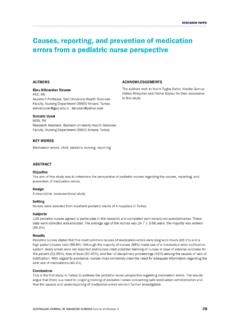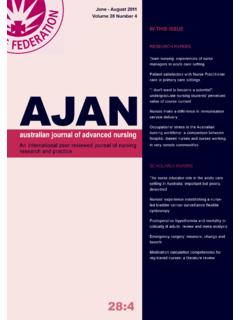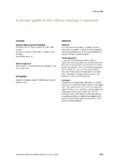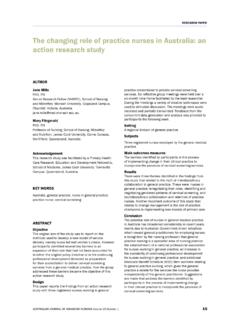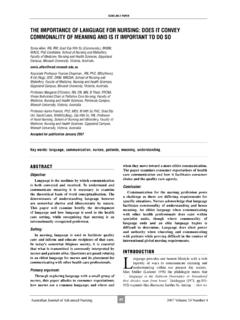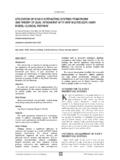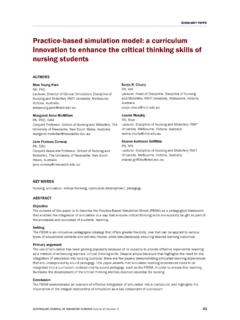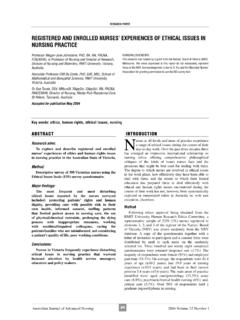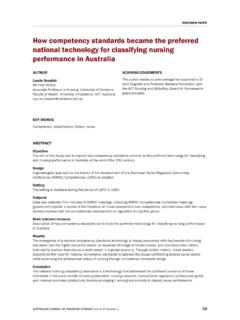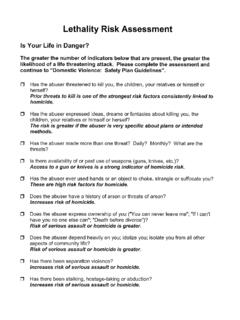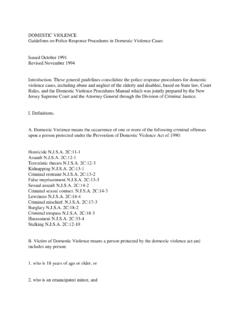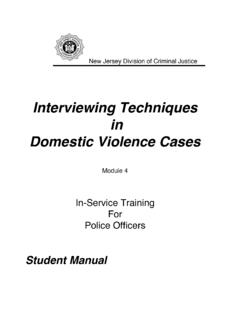Transcription of The safety of nurses during the restraining of aggressive ...
1 AUSTRALIAN JOURNAL OF ADVANCED NURSING Volume 29 Number 35 RESEARCH PAPERThe safety of nurses during the restraining of aggressive patients in an acute psychiatric unit AUTHORSN ompilo MoyoRN, BSc(Nurs), DipNEd, DipMHN&PN, MPH , MHAdmin Nurse Educator, Careers Australia Melbourne Australia. Robinson BNurs, MPH, MHSc( PHP), PhD Academic coordinator, MPH, MPH&MHA and MPH&MID programs School of Public Health and human biosciences, La Trobe University, Bundoora, Victoria, Australia. WORDSR estraining, physical assault, aggressive patients , ObjectiveThe aim of the study was to describe patterns of injuries sustained by nurses during the restraining of aggressive patients and to identify factors in the restraining process that can be modified to improve the safety of nurses during restraining .
2 Design Within method triangulation was used in this study and involved two quantitative data collection An adult acute psychiatric unit in Victoria, Australia. SubjectsSeven male and twenty six female outcome measures The outcome measures are patterns of injuries and ways of reducing injuries. ResultsIncident reports showed more than half of all injuries occurred in the afternoon shift and during the holding stage of restraining . Eighty percent of the injured nurses sustained multiple injuries. Questionnaire results showed that restraining was associated with an estimated increased risk of being injured of 25% (RR = , 95% CI= to , p > ).
3 The proportion of injuries was higher among female nurses ( ) compared with male nurses ( ), (RR= , 95% CI = to , p > ). Lack of group co ordination was perceived as the main contributor to injury. Introducing easier restraining techniques and increasing the training period were identified as ways that might improve the safety of injuries occurred at the holding stage of restraining and in the afternoon shift. Many participants sustained multiple injuries and most of the injuries were caused by physical assaults. There is need for improving group coordination during restraining to increase the safety of nurses .
4 AUSTRALIAN JOURNAL OF ADVANCED NURSING Volume 29 Number 36 RESEARCH PAPERINTRODUCTIONThe injuries sustained by nurses in mental health services is a global problem, and there is a worldwide concern for the safety of nurses (Duxbury and Paterson 2005; Erdos and Hughes 2001). While the core business of nursing is to improve patients health, occupational health and safety of the people who nurse them also needs to be promoted and protected. Mahoney (1991) states that assaults of nurses by patients result in emotional responses including anger, anxiousness, sense of helplessness, loss of control and increased irritability.
5 Physical injuries sustained from assault may heal quickly, but the emotional trauma lasts longer (Bruser 1998). This study was designed to identify ways of reducing injuries to nurses during restraining thereby promoting physical and mental health of nurses . LITERATURE REVIEWThe use of restraining in hospitals Control and Restraint is the most commonly taught manual technique for the management of aggression and has existed in mainstream psychiatry for approximately 15 years, yet there is little research on its safety and effectiveness (Southcott and Howard 2007). Leadbetter (1995) identified four components used when employing physical restraint, namely: the immobilisation of the subject through the use of body weight and strength; the restriction of limb movement by employing some form of hold; keeping the subject in an off balance position; and the use of reasonable force.
6 The mental health unit which is the subject of the current study uses the components identified by Leadbetter (1995) for controlling and restraining authors in the current study divided the restraining process into three stages in order to facilitate the description of patterns of injuries. The first stage is the restraint initiation, where nurses move towards restraining the patient. The second stage is holding, where nurses maintain the patient in an immobilised state using special holds (called locks ). The last stage is exit, where nurses loosen their hold on the patient and move away from the patient.
7 Patterns of nurses injuries during restrainingIt appears that injury of staff during restraining is not uncommon, although prevalence estimates vary. A study by Graham (2002) showed that in 81 episodes of restraint there were 13 episodes (16%) which resulted in abrasions to either patients or staff, and a study by Carmel and Hunter (1989) revealed that two thirds of staff members were injured during containment procedures and most of them sustained injuries to the body extremities. Factors associated with nurses injuries during restrainingDowson et al (1999) revealed that staff injured whilst restraining patients had not been trained in restraining .
8 Wright (2003) asserts that staff and patient injuries during restraining are caused by poorly executed and ill defined restraining techniques. Southcott and Howard (2007) demonstrated that gender had no effect on the safety of restraining . This might be explained by the fact that female and male nurses receive the same training in of reducing injuries to nurses during restrainingThe Australian Nursing Federation (ANF) (Victorian Branch) provides education to nurses on the prevention of injuries and management of violent incidents by conducting seminars on prevention of violence against nurses (ANF Victorian Branch 2009).
9 ANF (Victorian Branch) endorsed a zero tolerance policy for occupational violence and aggression towards its members (ANF Victorian Branch 2006). The policy helps to prevent injuries to nurses because it does not accept occupational violence and aggression (ANF Victorian Branch 2006).AUSTRALIAN JOURNAL OF ADVANCED NURSING Volume 29 Number 37 RESEARCH PAPERAs there is a paucity of research conducted amongst nurses about injuries sustained during restraining of patients there is clearly a need for more study on this subject. AIM OF THE STUDYThe aim of the study was to describe patterns of injuries sustained by nurses during restraining of aggressive patients and to identify factors in the restraining process that can be modified to improve the safety of nurses during restraining , in a mental health acute ward in Victoria, Australia.
10 The specific objectives were: 1. To identify patterns of injuries to nurses sustained during the restraining procedure. 2. To explore nurses perceptions of factors associated with their injuries during the restraining To explore the nurses perceptions on ways of improving their safety during the restraining Within method triangulation was used in this study and involved two quantitative data collection methods. Within method triangulation is used when the phenomenon being studied is multidimensional. For example two or three different quantitative instruments might be used to measure the same phenomenon.
